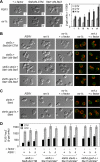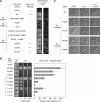Distinct roles for two Galpha-Gbeta interfaces in cell polarity control by a yeast heterotrimeric G protein
- PMID: 17978098
- PMCID: PMC2174166
- DOI: 10.1091/mbc.e07-04-0385
Distinct roles for two Galpha-Gbeta interfaces in cell polarity control by a yeast heterotrimeric G protein
Abstract
Saccharomyces cerevisiae mating pheromones trigger dissociation of a heterotrimeric G protein (Galphabetagamma) into Galpha-guanosine triphosphate (GTP) and Gbetagamma. The Gbetagamma dimer regulates both mitogen-activated protein (MAP) kinase cascade signaling and cell polarization. Here, by independently activating the MAP kinase pathway, we studied the polarity role of Gbetagamma in isolation from its signaling role. MAP kinase signaling alone could induce cell asymmetry but not directional growth. Surprisingly, active Gbetagamma, either alone or with Galpha-GTP, could not organize a persistent polarization axis. Instead, following pheromone gradients (chemotropism) or directional growth without pheromone gradients (de novo polarization) required an intact receptor-Galphabetagamma module and GTP hydrolysis by Galpha. Our results indicate that chemoattractant-induced cell polarization requires continuous receptor-Galphabetagamma communication but not modulation of MAP kinase signaling. To explore regulation of Gbetagamma by Galpha, we mutated Gbeta residues in two structurally distinct Galpha-Gbeta binding interfaces. Polarity control was disrupted only by mutations in the N-terminal interface, and not the Switch interface. Incorporation of these mutations into a Gbeta-Galpha fusion protein, which enforces subunit proximity, revealed that Switch interface dissociation regulates signaling, whereas the N-terminal interface may govern receptor-Galphabetagamma coupling. These findings raise the possibility that the Galphabetagamma heterotrimer can function in a partially dissociated state, tethered by the N-terminal interface.
Figures









Similar articles
-
Phosphorylation of Gβ is crucial for efficient chemotropism in yeast.J Cell Sci. 2013 Jul 15;126(Pt 14):2997-3009. doi: 10.1242/jcs.112797. Epub 2013 Apr 23. J Cell Sci. 2013. PMID: 23613469
-
Gβ promotes pheromone receptor polarization and yeast chemotropism by inhibiting receptor phosphorylation.Sci Signal. 2016 Apr 12;9(423):ra38. doi: 10.1126/scisignal.aad4376. Sci Signal. 2016. PMID: 27072657 Free PMC article.
-
The Gbeta(KlSte4p) subunit of the heterotrimeric G protein has a positive and essential role in the induction of mating in the yeast Kluyveromyces lactis.Yeast. 2005 Sep;22(12):947-56. doi: 10.1002/yea.1278. Yeast. 2005. PMID: 16134098
-
Invited review: Activation of G proteins by GTP and the mechanism of Gα-catalyzed GTP hydrolysis.Biopolymers. 2016 Aug;105(8):449-62. doi: 10.1002/bip.22836. Biopolymers. 2016. PMID: 26996924 Free PMC article. Review.
-
Mechanistic pathways and biological roles for receptor-independent activators of G-protein signaling.Pharmacol Ther. 2007 Mar;113(3):488-506. doi: 10.1016/j.pharmthera.2006.11.001. Epub 2006 Nov 28. Pharmacol Ther. 2007. PMID: 17240454 Free PMC article. Review.
Cited by
-
Heterotrimeric G-protein subunit function in Candida albicans: both the alpha and beta subunits of the pheromone response G protein are required for mating.Eukaryot Cell. 2008 Sep;7(9):1591-9. doi: 10.1128/EC.00077-08. Epub 2008 Jul 25. Eukaryot Cell. 2008. PMID: 18658257 Free PMC article.
-
CDK and MAPK Synergistically Regulate Signaling Dynamics via a Shared Multi-site Phosphorylation Region on the Scaffold Protein Ste5.Mol Cell. 2018 Mar 15;69(6):938-952.e6. doi: 10.1016/j.molcel.2018.02.018. Mol Cell. 2018. PMID: 29547722 Free PMC article.
-
Regulation of cell signaling dynamics by the protein kinase-scaffold Ste5.Mol Cell. 2008 Jun 6;30(5):649-56. doi: 10.1016/j.molcel.2008.04.016. Mol Cell. 2008. PMID: 18538663 Free PMC article.
-
Ratiometric GPCR signaling enables directional sensing in yeast.PLoS Biol. 2019 Oct 17;17(10):e3000484. doi: 10.1371/journal.pbio.3000484. eCollection 2019 Oct. PLoS Biol. 2019. PMID: 31622333 Free PMC article.
-
Chemical gradients and chemotropism in yeast.Cold Spring Harb Perspect Biol. 2009 Aug;1(2):a001958. doi: 10.1101/cshperspect.a001958. Cold Spring Harb Perspect Biol. 2009. PMID: 20066086 Free PMC article. Review.
References
-
- Apanovitch D. M., Iiri T., Karasawa T., Bourne H. R., Dohlman H. G. Second site suppressor mutations of a GTPase-deficient G-protein α-subunit. Selective inhibition of Gβγ-mediated signaling. J. Biol. Chem. 1998;273:28597–28602. - PubMed
-
- Arkowitz R. A. Responding to attraction: chemotaxis and chemotropism in Dictyostelium and yeast. Trends Cell Biol. 1999;9:20–27. - PubMed
-
- Ayscough K. R., Drubin D. G. A role for the yeast actin cytoskeleton in pheromone receptor clustering and signalling. Curr. Biol. 1998;8:927–930. - PubMed
-
- Bagorda A., Mihaylov V. A., Parent C. A. Chemotaxis: moving forward and holding on to the past. Thromb. Haemost. 2006;95:12–21. - PubMed
-
- Bar E. E., Ellicott A. T., Stone D. E. Gbetagamma recruits Rho1 to the site of polarized growth during mating in budding yeast. J. Biol. Chem. 2003;278:21798–21804. - PubMed
Publication types
MeSH terms
Substances
Grants and funding
LinkOut - more resources
Full Text Sources
Molecular Biology Databases

